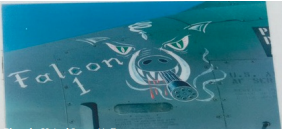
by Melissa LaScaleia
Painting art on the nose of military planes, known as nose art, is a tradition that dates back to World War I in America.
The typical art during this time was mainly that of embellished squadron insignia and many don’t rank it among true nose art.
After the war, the military became more strict with regulations in an attempt to phase out the practice. With the dawning of the Second World War however, there was a resurgence, when the regulations were relaxed or deliberately ignored in favor of artistic expression. It was the period of history that saw the golden age of aircraft nose artistry.
Living in wartime, when every flight could be your last, nose art served as a powerful morale booster. It put a smile on the face of servicemen risking their lives for their country and encouraged them.
During such tense and uncertain times, many crew developed bonds with their planes, and the personalization via art served to strengthen that bond. Many grew to feel that the art was a good luck symbol. The nose art unified the crew, as it distinguished them from all of the others in their unit or base, and gave them something additional to rally behind and take pride in.
Artwork varied in preferences, but common themes often included that of pin-up girls, scenes of home, patriotic or good luck symbols, and animals real and imagined, like tigers, sharks, and dragons. Others included cartoon characters and fierce messages of enmity for the enemy.
Another common theme which bolstered morale and reaffirmed the mission of the U.S. position during the war, was depictions of the U.S. as warriors against evil.
Sometimes faces were drawn that took on a life of their own, and many had accompanying writing, like the name of a commander or the plane’s nickname.

After WWII, nose art again phased out, with again, a brief resurgence for the Korean War. The themes remained similar—women, good luck, and home. It again re-emerged during the Vietnam War, but stricter regulations and fewer planes, which had to be shared, limited nose art more than it had in the past.
The themes changed too— pin-up girls were replaced with rock groups, reflecting the cultural shift from the repressive perspectives of women in the ’50s to the greater freedom, equality, and openness of the ’60s. Rather than messages of enmity and conquest, there were peace symbols and representations of popular cultural icons.
During the first Gulf War, Lt. Col. Mike McGee, of the Myrtle Beach Air Force Base, was deployed to King Fahd International Airport in Saudi Arabia. In the months leading up to Dessert Storm, Mike had a lot of time on his hands, and one day decided to paint the name of his commander on the nose of an A-10. He hoped his commander would be pleased and commission him to do nose art on all the aircraft.
However, the day proved to be hot, so hot that Mike couldn’t finish the job in one go, and needed to take a break before continuing. He fell asleep, and the half-completed name-painting was discovered before he could finish, with an inquiry made as to the culprit. Mike was ushered into his commander’s presence, who was impressed enough with his painting skills that he asked him to paint a warthog smoking a gun on the plane, in lieu of his name.
Mike followed suite, but couldn’t resist a small tribute to his commander in the corner.




















